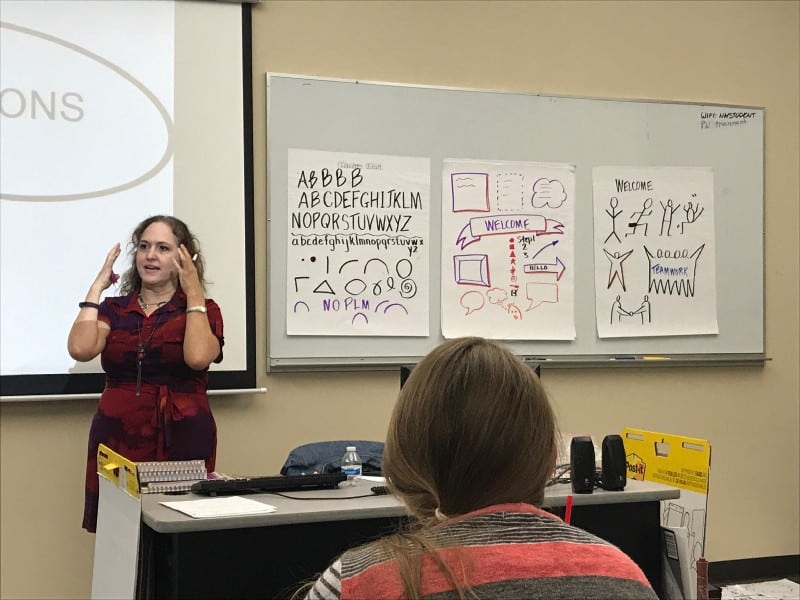
In August, I receive an email from ATD Austin with the subject “But I can’t draw…”. At the time I was thinking a lot about capturing ideas and output during Design Sprints and how this is a struggle for me due to my lack of illustration skills. This email seemed relevant so I clicked to see what it was all about. Turns out that ATD was offering a workshop titled “A Practical Application of Visuals for the Learning Environment” led by Patricia Selmo a Graphic Recorder. I signed up!
Prior to the workshop I did a little investigation and found that the Grove seems to be ground zero for Graphic Recording and Graphic Facilitation. They conduct training, provide resources, and sell facilitation supplies. Also, David Sibbet’s books, Visual Meetings, Visual Teams, and Visual Leadership are well regarded. I picked up a couple of his books and enjoyed flipping through them in anticipation of the workshop.
“The reason we think we’re not visual… is because just when we were starting to understand things… they took the pictures away.” — Dan Roam
The University of Waterloo conducted a study on the impact of drawings on memory. They found that when asked to remember words, study participants remember two times as many words when the word was associated with an image. “Need to remember something? Better draw it”
The Process
Graphic Recording is the translation of conversations into images and text on large sheets of paper during meetings and events. People talk and listen to ideas while the graphic recorder visualizes the discussion allowing everyone to see the big picture.
Graphic recording can help time-sensitive organizations get the most out of their meetings. With a graphic recorder capturing the conversation through concise imagery and text, listeners are engaged visually in the meeting. This encourages people to build upon the discussion and the speaker, in turn, can see how his or her input is being interpreted.
Benefits of Graphic Recording
21% Increase in reaching consensus
24% Shorter meetings
70% More memorable
80% More effective meetings.
A visual map of the entire conversation is created. Validating everyone’s point of view and serving as a powerful record of the work accomplished. At the end of the meeting, the large colorful mural is photographed and the images can be referenced and used online, in videos, presentations, and other marketing collateral.
The Workshop
Patricia Selmo is a graphic recorder (also known as a visual storyteller or a live scribe), content creator and coach with 20+ years of experience in Instructional Design, Business Analysis, Project and Change Management. By combining this with her strengths in listening and pattern-finding. She helps bring life to boring meetings, guides coaches and consultants in creating their own programs and packages while helping individuals and teams make the difference they are destined to make in the world.

Patricia provided some great drawing tips and techniques that anybody could use to improve their drawing, lettering, and formatting. She helped us think about how to hold the markers properly and I learned that Graphic Recorders prefer “juicy” markers such as Neulands and Charters. In addition to demonstrating some standard shapes, she focused on lettering and concepts.
Lettering
- Slow down
- Stand directly in front of your current letter, move your body as you write
- Use your pinky for stability and a line guide
- Make every stroke unique and distinct
- Use capital letters
- Only use dark colors: black, blue, brown
- Don’t use more than 2 colors for text
- Use red sparingly and intentionally to draw attention

Concepts
- Use whatever icon pops in your head
- If the icon is too abstract, label it
- For faces and expressions, think about the placement of the eyes and shape of the mouth
- Build up your own tool kit of “go to” icons especially for common themes and ideas
- When in doubt, Google images for reference on something looks
At the end of the workshop, Patricia gave away a free consult and I won! I scheduled a consult with her and it was a pleasure to get to know her more. It turns out that she has a background in technical writing and in addition to graphic recording she is currently working with an interesting PE firm. I hope we have an opportunity to work together sometime in the future.
The very next week I attended Anna’s Liberating Structures workshop and guess what they were doing? Graphic Recording! It was a pleasure to experience something I just learned about put into action without expecting it. Amanda and Anna took turns capturing the key ideas as the workshop progressed on the wall. This helped focus the group’s attention and strengthen their retention of the concepts. Attendees regularly referred back to the drawings.

I’m convinced, graphic facilitation adds value to business meetings and co-creation sessions. Consider doing it yourself so that you can:
- Illustrate a complex flow of activity
- Create a structure to organize information
- Energize participants towards creative participation
- Help make connections between thoughts to move to a complete view of the problem being discussed

If you are facilitating Design Sprints, consider drawing some inspiration from graphic recording to elevate the visual experience for your participants. If you are simply looking to improve your team, draw to remember more!


